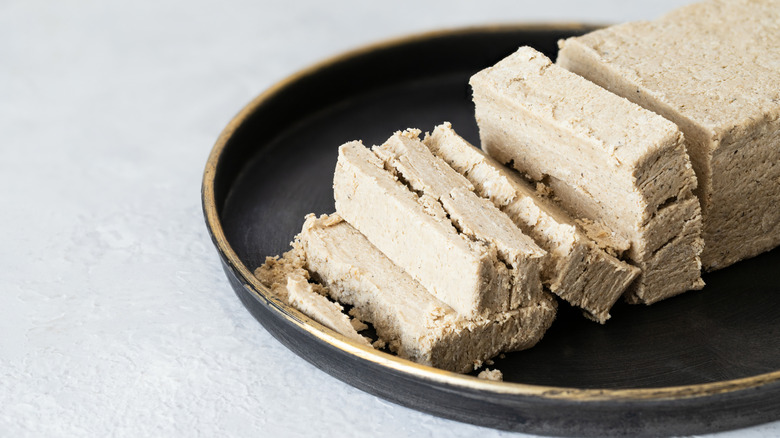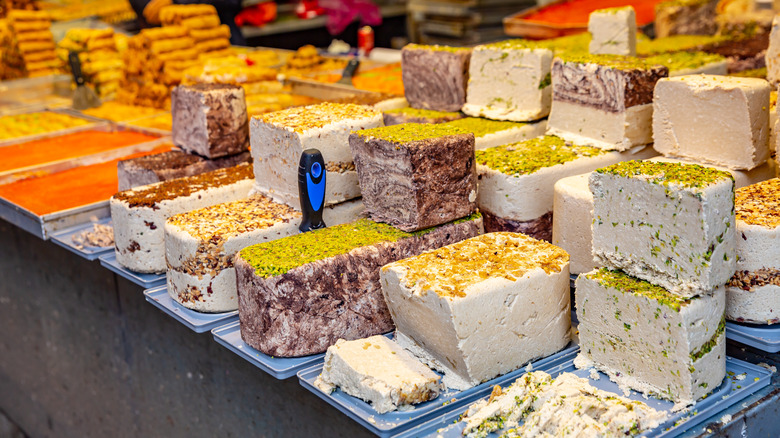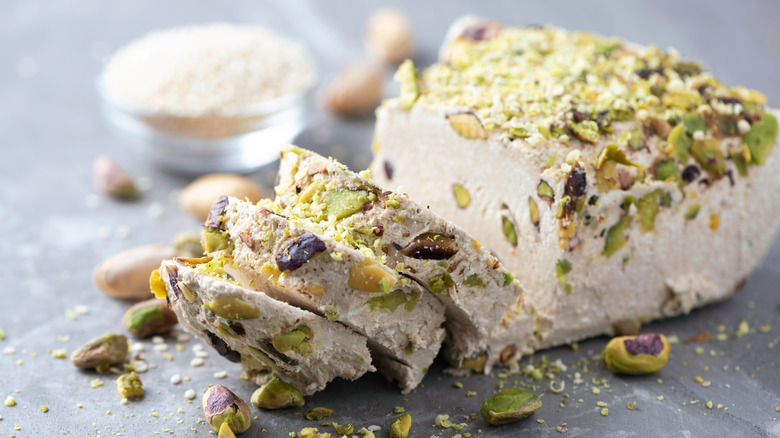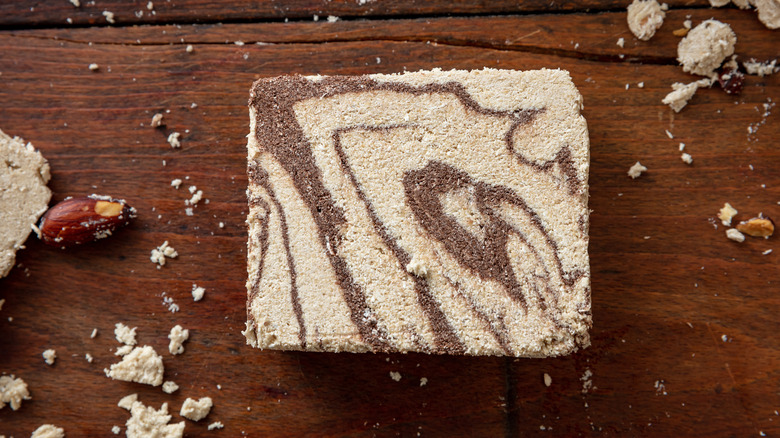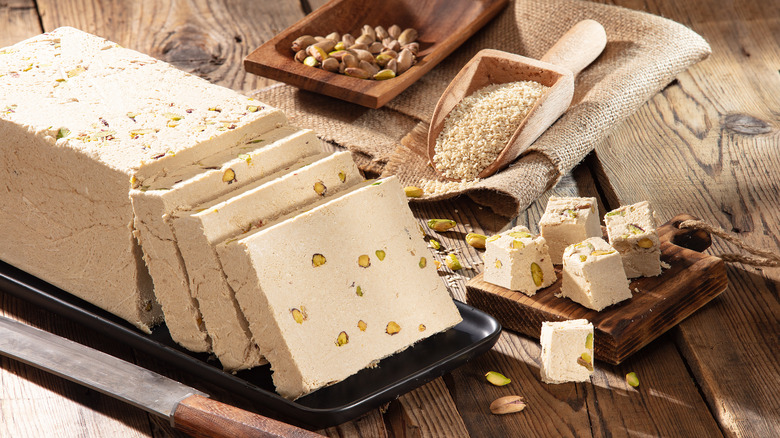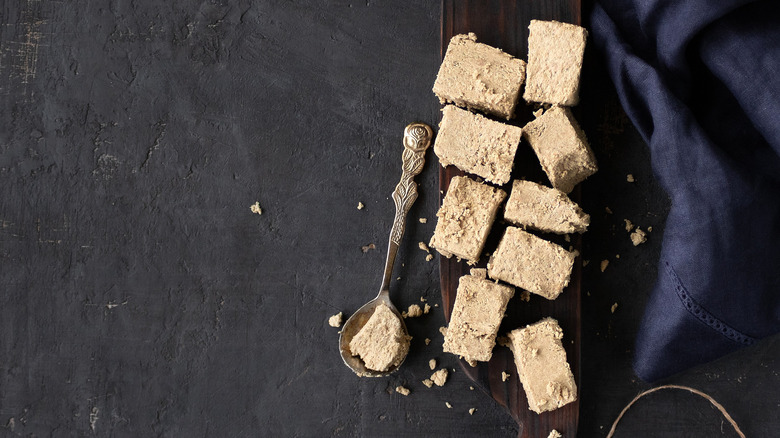What Is Halva And What Does It Taste Like?
Those who have lived in or traveled to the Middle East have probably seen halva at the region's markets. Wheels of the fudgy treat are often displayed for sale there, according to New York Times Cooking. Though halva (also spelled halvah) is an ancient sweet that originated in the Middle East, it is quite popular and common throughout the Balkan Peninsula, North Africa, and India, as well, per Halvamania.
While halva is often eaten as a confection or dessert, some consider it to be one of the world's oldest food supplements due to its nutritious makeup of protein, healthy fats, and more. While halva does pack in some vital nutrients, it is also an incredibly sweet treat that makes the end of any meal feel special. Whether you are completely new to halva or want to try making your own flavor at home, here's everything you need to know about this ancient specialty.
What is halva?
The halva candy is most commonly made from a nut base, though flour-based halva also exists, according to The Kitchn. Traditionally, ancient halva was made from dates and milk or sesame seeds and honey, per Halvamania. These days, it's usually made with crushed sesame seeds and a sugar syrup. It can be enjoyed plain or with added flavors like cocoa powder, vanilla, other nuts, or even dried fruits. The beauty of making halva at home is that you can experiment with any flavors you would like to try. You can incorporate various extracts, citrus zest, or any of your favorite ingredients for an interesting twist on tradition.
Halva that is made without any added flavors tends to rely on a very strong type of tahini, which is a paste made of ground sesame seeds. Tahini is one of the key ingredients for making halva, so without any extra ingredients, this is the most important ingredient that gives the confection its taste and texture. The other key ingredient, of course, is sugar, which is dissolved in water to make the syrup.
How is halva made?
Unlike some types of candies and confections, halva is actually pretty to make, based on a recipe shared by New York Times Cooking. It starts with the sugar syrup, which is made by simmering sugar in a pot of water and allowing it to dissolve (without stirring) until it reaches a temperature of 245 degrees Fahrenheit. Next, the syrup is streamed into a bowl of tahini to be briefly mixed into a sticky paste. This is definitely a task that calls for a stand mixer with a guard, as you certainly don't want hot sugar syrup flying out of the bowl as it whips up.
At this point, it's all about timing: The tahini and syrup should be mixed for just about a minute, until the halva is thick and not grainy. The mixture is finally smoothed into a parchment-lined pan and left to cool, after which it can be sliced into smaller pieces for serving. Next comes the hardest part: cleaning that sticky mixing bowl, which is probably why many people prefer to leave the halva making to the professionals.
What does halva taste like?
While halva certainly has a unique flavor, its rich yet delicate texture usually becomes the focal point to those who are new to the candy, as was the case for The Kitchn. Otherwise, the flavor of the treat is largely determined by any add-ins, such as chocolate, vanilla, or pistachios. Without extra ingredients, plain halva primarily has the mild, nutty, and toasty flavor of tahini, or ground sesame seeds. However, instead of detecting only the taste of tahini (which Cook's Illustrated says can be bitter), you'll also get a balancing sweetness from the sugar syrup.
Apart from the taste, the texture of halva is sort of like a unique take on fudge. While halva has a thick, dense mouthfeel like chocolate fudge, it is also much messier and more crumbly. According to The Kitchn, there is no other candy quite like it, so if you plan to try halva, buy a flavor that interests you and get ready for a sweet, unique experience.
Where can you buy halva?
For most people, finding halva should not prove particularly difficult. Depending on where you live, your local grocery store may carry the sesame-based confection. A quick Google search reveals that Walmart, Kroger, and other supermarket chains sell the Middle Eastern treat. If you don't have luck there, visiting specialty stores or international markets may also a good way to find halva.
Of course, you can always order halva online from smaller makers if you have the patience. If you do so, just be sure to pay attention to the package size — especially if you are trying the candy for the first time. After all, you don't want to end up with a bulk-sized box of the treat if you're not sure that you love it. Finally, you could try exploring halva and halva-flavored treats in your local community from Middle Eastern restaurants, bakeries, dessert shops, and more.
Nutritional information about halva
Halva, when made with a sesame seed base, contains pretty significant stores of minerals, beneficial fats, protein, and other nutrients — even though its sugar content may prompt some to eat the treat in moderation. Impressively, a 1-ounce serving of halva has enough phosphorus and copper to satisfy 17% of your daily need for the minerals, according to Livestrong. It also has 15% of your daily value of magnesium and 12% of manganese.
As for other nutritional stats, a 1-ounce serving of halva packs in a total of 131 calories and 17 grams of carbs. Moreover, each serving has 3.5 grams of protein and about 6 grams of fat, most of which is unsaturated. Halva has 1.3 grams of fiber, too, which makes it relatively filling for a candy. With so few ingredients, it's a suitable dessert for those looking for an alternative to more processed candy bars. Nevertheless, one of the two primary ingredients in halva is sugar, so anyone who is monitoring their sugar intake may prefer to enjoy the confection on an occasional basis.
